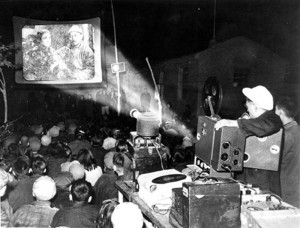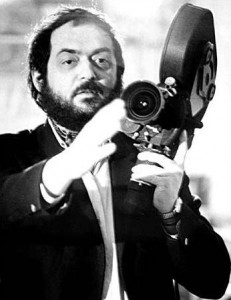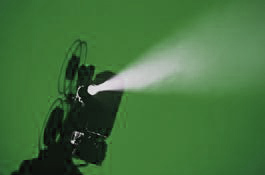
Rental Store • Open-Source Film • The Black List • 3D • Odd Future
![]()

There’s been a lot of noise online lately about projection standards in this country, and it makes a gentleman sad. Firstly, because it’s an absolute fact that projection is not taken as seriously as we would all like, and there are probably hundreds of showings a day that have some kind of sub-standard bullshit going on. This is more important to combat than ever as people increasingly cozy up to their home systems and ignore the theaters, and my ultimate point is that a call to action is necessary. But all the ranting and raving out there bothers me for another reason as well, and that’s because it kicks up my skeptical, bullshit context instinct.
Before I get into my silly list of grievances, you should know this was sparked by “news” that Terrence Malick has sent special instructions along with Tree Of Life prints that guide projectionists on how to make sure the film is properly screened. They are quite simple, and run as follows:
- Project the film in it’s proper 1.85:1 aspect ratio.
- The correct fader setting on Dolby and DTS systems is 7. Malick asks that faders be kept at 7.5 or even 7.7, system permitting.
- The film has no opening credits, and the booth operator is asked to make sure the “lights down cue is well before the opening frame of reel 1.”
- Operators are asked that lamps are at “proper standard (5400 Kelvin)” and that the “foot Lambert level is at Standard 14.”
Now that’s fun inside baseball stuff to read, but it’s also completely unremarkable. Prints come with special instructions all the time, especially if there is any peculiarity to the film that might require that it be built or shown in any unusual way. The lack of opening credits on Tree of Life is a perfect example. This is not necessarily a sign of a grand crusade from Malick against shitty projection- it’s a cherry picked bit of routine that only seems notable because of the narrative that’s been created recently. In fact, the only note that goes beyond routine instructions that would be with any film is the fader note- applicable because the film features very little dialogue, and much of whispered. It also features a very subtle sound bed that includes a lot of quiet detail.
I picked up on this notice from an article by the delightful and often brilliant Matt Goldberg at Collider, who prefaces his article with a mention of an X-Men: First Class screening in Atlanta. He says the screening was “fuzzy” and implies that it was out of focus, but I was at that screening and I have to heartily disagree. The projection was in perfectly acceptable focus, but there was a discernible “fuzziness” to title cards that was (in all likelihood) the result of projector shake/vibration. This is a natural part of every 35mm showing ever, because the projector is filled with moving parts. Obviously the amount of shake varies, but it’s usually only noticeable on title card and other distinct, sharp lines against black. In this case the vibration was stronger than I’d like, but it melted away in any full color image, as it does with virtually every analogue print screening. Take a look next time you’re at the theater- those titles are never perfectly sharp on a 35mm projection. It’s impossible for them to be, which creates a stark contrast against digital projection. That’s the reason I always prefer digital projection: no moving parts = perfectly crisp image, every time.
Now here’s the deal- I gain nothing by implying that the projection status quo is not in need of improvement. As it was when I got sick of Ebert’s hyperbolic crusade against 3D, I feel valid points are being made with largely invalid or hole-filled arguments. It’s what pisses me off when Fox news happens to me, or when people blame video games for every childhood problem, and it frustrates me here. What I’m driving at is there are a few things about some other common talking points that are a little narrow. Nuance, context, and full understanding are necessary if we’re actually going to petition for change.
• The 2D/3D lensing issue – this all sprang from a report stating that many chain theaters are failing to switch between 2D and 3D lenses, which results in some 2D showings being underlit and unnecessarily polarized. This is, of course, fucked up. The problem is (and this will become a common theme) is that the power of suggestion has meant that everyone has to started to cry “witch” at every screening they attend, and for issues that likely have nothing to do with this problem. From my admittedly limited view of twitter, comments, message boards, and other writer’s pieces, you’d think someone had flipped a switch and suddenly every screening is completely unwatchable. This is the power of suggestion at work, and an example of folks knowing just enough to be dangerous. It’s a problem, but the landscape of shitty projection is much more complicated than just that. There are a shit-ton more issues to fix with projection as well, and we need to understand the nuances of the projection art.
 • This Shit isn’t New – The backlash against 3D has reached a fever pitch as the format has in two short years become a fully saturated technology in theaters. I’ve been quite outspoken about my feeling on 3D and caught pretty much nothing but condescension in return, but regardless, the tone of the conversation has shifted to outright hatred. That’s fine I guess, but as news like the 3D lens issue mentioned above come out, it has seemingly absorbed the shitty projection conversation and amplified it in such a way that now we are in a projection “crisis.” The thing is- projection hasn’t been a sacred art for a long time. Stanley Kubrick was upset with the state of things over 20 years ago, and he discussed it at length with Rolling Stone in 1987.
• This Shit isn’t New – The backlash against 3D has reached a fever pitch as the format has in two short years become a fully saturated technology in theaters. I’ve been quite outspoken about my feeling on 3D and caught pretty much nothing but condescension in return, but regardless, the tone of the conversation has shifted to outright hatred. That’s fine I guess, but as news like the 3D lens issue mentioned above come out, it has seemingly absorbed the shitty projection conversation and amplified it in such a way that now we are in a projection “crisis.” The thing is- projection hasn’t been a sacred art for a long time. Stanley Kubrick was upset with the state of things over 20 years ago, and he discussed it at length with Rolling Stone in 1987.
“…theaters try to put in a screen that’s larger than the light source they paid for. If you buy a 2000-watt projector, it may give you a decent picture twenty feet wide. And let’s say that theater makes the picture forty feet wide by putting it in a wider-angle projector. In fact, then you’re getting 200 percent less light. It’s an inverse law of squares. But they want a bigger picture, so it’s dark.
Many exhibitors are terribly guilty of ignoring minimum standards of picture quality. For instance, you now have theaters where all the reels are run in one continuous string. And they never clean the aperture gate. You get one little piece of gritty dust in there, and every time the film runs, it gets bigger. After a couple of days, it starts to put a scratch on the film. The scratch goes from one end of the film to the other. You’ve seen it, I’m sure.”
That’s a hell of a statistic there: 200% dimmer, no? Makes the scary 85% dimmer figure from all the 3D kerfuffle seem positively tame! We’re dealing with light and physics though, so few people have a true understanding of those numbers actually mean. At the end of the day we just know that a screening should be bright, and should be even brighter if it’s going to be viewed through a gray-toned pair of glasses.
• There’s a silver lining to all of this – The benefit of all this paradigm shift is that major players like James Cameron are now invested in these systems, and they have the power to affect real change, even inadvertently. For Avatar, Cameron oversaw dozens of different formats of release, and took great care to make sure individual theaters were projecting the film properly. Now 3D films have become routine, theaters have slacked off their event-film standards, dimmed projectors for cost efficiency, and grown lazy with protocol. Cameron acknowledged this in his most recent talk about 3D, and getting projectors back up to full brightness is part of his campaign as he continues to push for digital, 3D, and high frame rates in theaters.
It’s also important to note that many of these growing pains are the results of amazing technology being integrated in a less than graceful fashion. I’ve yet to have a theatrical experience that matched the sheer joy of watching a week’s worth of well-projected, bright films on the Sony 4k projector that is the target of so much scorn, as I did at the SavFF. It’s a wonderful machine that is currently mired in protections and DRM features that cripple efficiency. More and more these systems are being centralized and digitized though, in such a way that studios may soon be able to monitor every detail of every screening of their films. We’re at a stumbling point currently, but we’re marching towards a very very near future wherein there lies the potential for more standardization than ever.
 It’s absolutely true though: we can’t sit and passively wait for it to happen. Prices are rising and in return we’ve got to actively demand better service, in an educated manner. You can do this. Be observant at your screenings from the very start and recognize if the focus or dimness is an issue, and if there’s a problem speak up. Not everyone considers themselves a “complainer” but you should always be confident in asking for what you paid for. However, do so in a way that may actually make progress- be firm but be courteous, don’t make assumptions, and follow up. Since I was able to go to movies under my own volition, I’ve always made it a point to be pro-active at cineplexes and I’ve had better experiences (or been adequately compensated for sup-par ones) ever since. While old school customer service seems to have died in virtually every industry, I promise you can still get very far with a relaxed tone, polite words, and willingness to listen. And if you speak with a manager about a problem, see them again when the show is over to let them know if you saw improvement, or if the problem persisted. More than just getting you free return tickets, this is the kind of thing that affects the people who can change practices. It lets them know it’s worth it, and that people are noticing.
It’s absolutely true though: we can’t sit and passively wait for it to happen. Prices are rising and in return we’ve got to actively demand better service, in an educated manner. You can do this. Be observant at your screenings from the very start and recognize if the focus or dimness is an issue, and if there’s a problem speak up. Not everyone considers themselves a “complainer” but you should always be confident in asking for what you paid for. However, do so in a way that may actually make progress- be firm but be courteous, don’t make assumptions, and follow up. Since I was able to go to movies under my own volition, I’ve always made it a point to be pro-active at cineplexes and I’ve had better experiences (or been adequately compensated for sup-par ones) ever since. While old school customer service seems to have died in virtually every industry, I promise you can still get very far with a relaxed tone, polite words, and willingness to listen. And if you speak with a manager about a problem, see them again when the show is over to let them know if you saw improvement, or if the problem persisted. More than just getting you free return tickets, this is the kind of thing that affects the people who can change practices. It lets them know it’s worth it, and that people are noticing.
I understand that my tone may be a bit mixed- that’s a symptom of my inherent desire to drag conversations back from the extremes to the middle. That’s not something that registers much today when your message has to compete with the THIS VS. THAT narrative, or has to grab eyes in 140 characters among hundreds of tweets. I’m just a dude who loves context is all, but I’m not about to say all is right in the world. Theaters need to do a better job, and we need to do a better job keeping them accountable. That’s more than saying “this shit looks like shit” or assuming we’re projection experts because we watch a lot of movies and read an article that one time. It means communicating like adults with people who are ultimately just doing a job.
There’s the potential for movies to look better than they ever have before. Let’s hope we can preserve the experience long enough for that potential to be fulfilled.
I’m interested to hear your take though. Do you think projection is pretty much in the toilet, or has all our connectivity simply amplified a complaint that’s always been there? Voice your voice!
DISCUSS THIS on the CHUD Message Board
&
Like / Share it on Facebook (above or below) if you think it’s great!